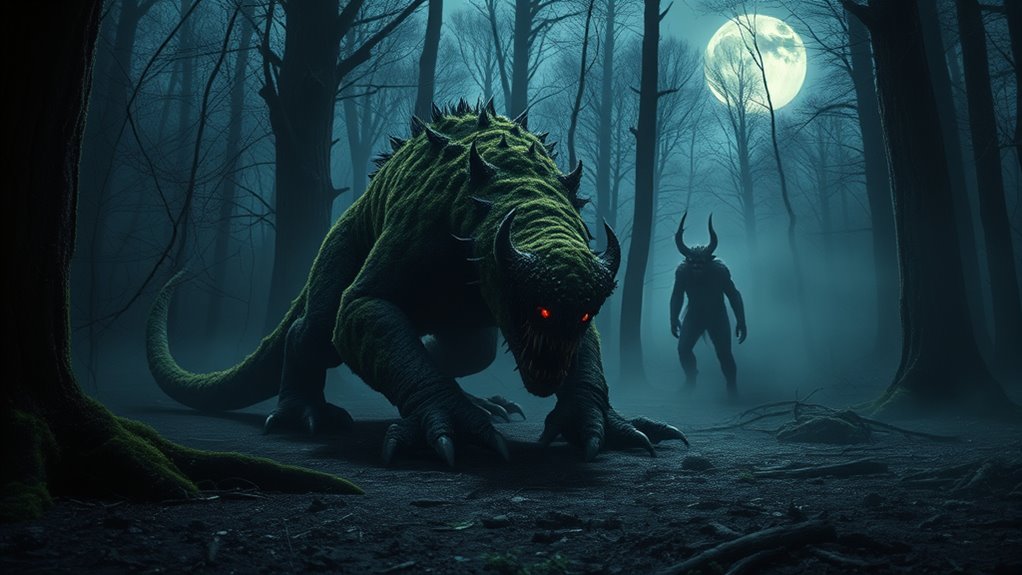Folklore creatures hunt and eat in ways that reflect cultural fears and mythic roles. Many stalk prey silently, using camouflage or supernatural abilities to ambush victims. Some lure prey with illusions or quick strikes, depending on their environment—water, forest, or mountain. Their feeding habits often symbolize deeper moral or spiritual lessons, rooted in tradition. If you keep exploring, you’ll discover even more fascinating ways these legends reveal cultural stories and universal fears.
Key Takeaways
- Folklore creatures often stalk prey stealthily, using camouflage or environmental features to ambush their victims.
- Many monsters employ supernatural abilities like illusions or supernatural pursuit to hunt or lure prey.
- Water-dwelling cryptids may attract prey through subtle movements or deceptive appearances in their aquatic habitats.
- Forest-based monsters rely on patience, camouflage, and surprise attacks aligned with their natural environment.
- Feeding behaviors symbolize cultural fears or moral lessons, often linked to curses, divine punishment, or mythic symbolism.

Have you ever wondered what motivates a monster’s behavior? When you explore the world of cryptid sightings and monster mythologies, you start to see that these creatures are more than just frightening legends—they’re shaped by stories that explain their actions. Many cultures have passed down tales of monsters that hunt and eat in ways that reflect their environment and the fears of the people who told them. These stories often serve as cautionary tales or explanations for unexplained phenomena in the wild, fueling the idea that monsters act according to certain patterns, instincts, and mythic roles. Understanding these behaviors helps you grasp why monsters are portrayed as they are across different cultures and how they fit into the mythologies surrounding them.
Monsters’ behaviors reflect cultural fears and mythic roles across diverse stories and traditions.
In countless cryptid sightings, witnesses describe creatures with hunting behaviors eerily similar to real animals, yet often exaggerated or supernatural in nature. These sightings reveal that monsters tend to stalk their prey stealthily, using camouflage or the environment to remain unseen. For example, legendary creatures like the Chupacabra or the Mothman are believed to have specific hunting styles—either ambushing prey or using their supernatural abilities to hunt from a distance. Monster mythologies often depict these beings as predators with unique methods of capturing and consuming food, whether it’s through swift, lethal strikes or by luring victims into traps. These behaviors aren’t random; they’re rooted in the creature’s supposed biology or supernatural powers, making them more terrifying and believable.
You might also notice that many monster stories emphasize their feeding habits as a way to evoke fear or highlight their otherworldliness. Some monsters are portrayed as bloodthirsty predators, driven by hunger or a cursed nature, while others are depicted as more calculated hunters, stalking their victims over long periods. Their methods of hunting often reflect the environment they inhabit—water-dwelling monsters like the Loch Ness Monster may lure prey with illusions or subtle movements, whereas forest-dwelling cryptids might rely on camouflage and patience. These behaviors are embedded in the mythologies surrounding them, shaping how people interpret their sightings and encounters. These stories often explain their feeding as part of their curse or divine punishment, adding layers of symbolism and mystery.
Ultimately, understanding the behavior of monsters within folklore and cryptid sightings allows you to see how these creatures embody human fears and cultural values. Their hunting and eating habits aren’t just about survival; they serve as stories that reinforce lessons or explain the unknown. Whether they’re depicted as cunning predators or supernatural beings driven by insatiable hunger, these behaviors reflect the deep roots of monster mythologies and the stories that have fascinated people for generations. By examining how these creatures hunt and eat, you gain insight into the fears, hopes, and cultural narratives that continue to shape our understanding of monsters today.
Frequently Asked Questions
Do Monsters Hunt Humans Intentionally or Accidentally?
In most folklore, monsters hunt humans intentionally, guided by their motivations and creature intelligence. They often see humans as prey or threats, actively seeking them out for food or dominance. Some folklore creatures attack accidentally, triggered by curiosity or mistaken identity, but generally, their motivations are driven by a desire to feed or assert power. Your understanding of their behavior reveals a mix of instinct and cunning rooted in their folklore origins.
Can Folklore Creatures Learn or Adapt Their Hunting Strategies?
A leopard can’t change its spots, but folklore creatures can learn and adapt their hunting strategies over time. Through cognitive evolution, they refine predator tactics, becoming more cunning and efficient hunters. You might think they’re static, but they evolve just like living predators, adjusting to new circumstances and prey. This adaptability keeps them dangerous and unpredictable, proving that folklore creatures aren’t just myths—they’re creatures that learn and grow.
Are There Differences in Hunting Behaviors Among Various Folklore Monsters?
You’ll notice that different folklore creatures display diverse mythical predator behaviors, reflecting their unique origins and stories. Some exhibit cunning intelligence, stalking prey with strategic patience, while others rely on brute force or surprise attacks. These variations highlight how folklore creature intelligence influences their hunting tactics, making each monster’s behavior distinct. By understanding these differences, you can better appreciate the rich diversity in mythological predator strategies across cultures.
How Do Monsters Choose Their Prey?
Monsters pick prey like a cat hunting mice, emphasizing prey selection and stalking tactics. You notice they often target the vulnerable or those who wander alone, using stealth and patience to close the gap. Their choices depend on factors like scent, sound, or appearance, making their stalking tactics precise and calculated. By understanding these methods, you see how monsters adapt their hunt to maximize their chances of success.
Do Monsters Hunt Seasonally or Based on Environmental Cues?
You notice that monsters often hunt based on environmental triggers rather than strict seasonal patterns. They respond to cues like prey availability, weather changes, and moon phases, which signal the best time to hunt. These environmental triggers help them maximize their chances of survival and success. So, rather than sticking to a calendar, monsters adapt their hunting behavior to the natural rhythms and seasonal patterns of their surroundings.
Conclusion
Remember, curiosity killed the cat, but understanding monsters reveals what truly lurks in the shadows. By studying their hunting and eating habits, you gain insight into fears and legends that shape cultures. Monsters may be myth, but their behaviors teach us about survival, caution, and the unknown. Keep your eyes open and your mind curious—sometimes, what we fear most is just the other side of understanding. After all, knowledge is the best defense against the darkness.










